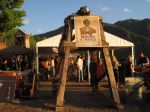For me, one of the best things about the Food & Wine Classic in Aspen is the opportunity it presents to meet winemakers and winery owners and to taste wines from producers whom I seldom or never get a chance to try. And this year, the event’s 30th anniversary shined on that score.
For instance, I had a chance to sit down with winemakers for two iconic (an over used word but it applies in this case) California wineries.
 Saturday morning over breakfast I met Gina Gallo, the winemaker for Gallo Family Vineyards in Sonoma. Ms. Gallo, who has been a winemaker for the family for more than two decades, was anxious to tell me about (and have me taste) her new portfolio of wines: the Gallo Signature Series. She explained she wanted to make wines that reflected the best of what California’s top growing regions (particularly her family’s estate vineyards)have to offer.
Saturday morning over breakfast I met Gina Gallo, the winemaker for Gallo Family Vineyards in Sonoma. Ms. Gallo, who has been a winemaker for the family for more than two decades, was anxious to tell me about (and have me taste) her new portfolio of wines: the Gallo Signature Series. She explained she wanted to make wines that reflected the best of what California’s top growing regions (particularly her family’s estate vineyards)have to offer.
So, signature has a triple meaning: grapes from signature California wine regions, wines made with special care by Gina Gallo, and labels bearing her signature. “I’m excited to have Gallo estate wines back in the market and to be back working with these wines full time after my recent maternity leave [twins!], Gina said while I sipped the three new wines. First, a well-balanced 2010 Chardonnay ($30) from the Laguna Vineyard in Sonoma. Then a full flavored 2010 Pinot Noir ($35) from Olson Ranch in the Santa Lucia Highlands of Monterey. Finally, a bold and structured 2009 Cabernet Sauvignon ($40) from the William Hill Estate in Napa (buttressed with fruit from the famed Monte Rosso Vineyard).
I would say the wines reflected the personality of their maker: reflective of their origins but with their own expression, welcoming but with depth. I look forward to following the evolution of this portfolio.
That afternoon, I joined Corey Beck, the winemaker for Francis Ford Coppola Winery, for snacks and conversation. Corey began with a little history. In 1975, Francis Ford Coppola and his wife Eleanor purchased portions of the historic Inglenook property and renamed it Niebaum-Coppola to honor Gustav Niebaum who founded the winery in 1879. They quickly established the property as a respected producer and as a major destination for tourists. They have now acquired the rest of the property and recently announced the winery henceforth will again be known as Inglenook again.
conversation. Corey began with a little history. In 1975, Francis Ford Coppola and his wife Eleanor purchased portions of the historic Inglenook property and renamed it Niebaum-Coppola to honor Gustav Niebaum who founded the winery in 1879. They quickly established the property as a respected producer and as a major destination for tourists. They have now acquired the rest of the property and recently announced the winery henceforth will again be known as Inglenook again.
In 2006, the Coppola’s purchased the Souverain property in northern Sonoma. They renamed it Francis Ford Coppola Winery and moved production of most of their portfolio there. They also put Corey in charge of all winemaking operations.
Corey has a life long connection to California wine, essentially growing up alongside his grandfather who was the vineyard manager for Napa Valley’s renowned Chateau Montelena and later as their Cabernet Sauvignon Cellar Master. Corey joined Coppola in 1998 as the assistant winemaker. He now oversees seven wine brands including Diamond Collection, Rosso & Bianco, Sofia, FC Reserve, Votre Santé, Director’s, and Director’s Cut. It also is worth noting Coppola has turned the winery into a major tourist destination with a gourmet restaurant, a swimming pool, bocce, and a movie gallery.
Circumstances prevented us from tasting any of Corey’s wines but I really enjoyed the conversation and the history. I also have recommended Coppola wines before and look forward to reporting about new releases in the coming months.
I also made numerous discoveries in the Grand Tasting Tent, where producers from all over the world display their wares. This year I ended up on sort of a world tour.
The journey started at the Wines of Germany table. Wines of Germany has hosted tables here for many years and I always make a point to stop by to taste samples of Riesling (my favorite white wine) from the country that does it best.
With Aldo Sohm, Wine Director of Le Bernadin Restaurant and Michael Schlemmel of Wines of Germany
Next Spain. Wines of Spain for many years has hosted a whole tent as a separate location within the Grand Tasting park and it is always a great place to hunt for new wines. This year I was especially impressed with the wines at the “Drink Ribera” (that’s Ribera del Duero, one of Spain’s most important regions).
From there it was a short walk to the Inter-Rhone table to taste through samples of Cote-Rotie and Chateauneuf-du-Pape and to a nearby table for a taste of Champagne Nocholas Feullate, even their Grand Marque “Palmes d’Or.”
Then it was a visit to the tables of the Instituto del Vino-Grand Marchi. This organization brings together 19 of Italy’s most important wineries, all family owned. I was giddy tasting wines from such producers as Antinori, Donnafugata, Pio Cesare, Michele Chiarlo, and Tasca d’Almerita.
I finished my tour in California. First I enjoyed tastes of the flagship red of Beaulieu Vineyard, the 2008 Georges de la Tour Private Reserve Cabernet Sauvignon, along with the 2008 Tapestry Reserve (Bordeaux-style blend), and 2009 Rutherford Cabernet Sauvignon.
I concluded with the founder of Buena Vista Winery, Count Agoston Haraszthy. Actually, it was actor George Weber playing the role convincingly (actually how would I know, since Haraszthy is long dead, having founded the winery in 1857). And Buena Vista now is owned by Burgundy-based Boisset Family Estates. But I was happy to have the Count, I mean George, taste me through several wines from Buena Vista (I especially liked the 2008 “The Count” Founder’s Red), and other Boisset-owned California properties: De Loach (2009 Green Valley Pinot Noir), and Raymond (2008 Raymond Rutherford Cabernet Sauvignon).
Weber playing the role convincingly (actually how would I know, since Haraszthy is long dead, having founded the winery in 1857). And Buena Vista now is owned by Burgundy-based Boisset Family Estates. But I was happy to have the Count, I mean George, taste me through several wines from Buena Vista (I especially liked the 2008 “The Count” Founder’s Red), and other Boisset-owned California properties: De Loach (2009 Green Valley Pinot Noir), and Raymond (2008 Raymond Rutherford Cabernet Sauvignon).
Needless to say, it was another year of discovery at the Food & Wine Classic in Aspen. I already can’t wait for next year.






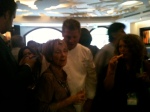
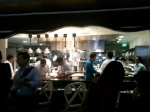
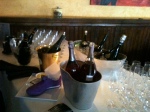 Next, it was off to Jimmy’s restaurant for a casual dinner hosted by Ferrer Wine Estates and featuringsome of their fine sparklers. While visiting with Eva Bertran, Executive Vice President at Freixenet USA, I enjoyed the Segura Viudas Reserva Heredad ($20) and Freixenet ElyssiaPinotNoir Brut from their extensive line of Cava. I also enjoyed talking and and tasting with Gloria Ferrer (the family’s California winery) winemaker Bob Iantosca. His limited release 2005 Anniversary Cuvee ($45) was especially complex and flavorful.
Next, it was off to Jimmy’s restaurant for a casual dinner hosted by Ferrer Wine Estates and featuringsome of their fine sparklers. While visiting with Eva Bertran, Executive Vice President at Freixenet USA, I enjoyed the Segura Viudas Reserva Heredad ($20) and Freixenet ElyssiaPinotNoir Brut from their extensive line of Cava. I also enjoyed talking and and tasting with Gloria Ferrer (the family’s California winery) winemaker Bob Iantosca. His limited release 2005 Anniversary Cuvee ($45) was especially complex and flavorful.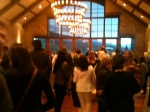 chef Jose Andres. Besidesgreat food, the event featured too many Spanish wines to taste them all or even keep tasting notes but I was impressed enough with the 2006 Bodegas Muga Reserva Seleccion ($40) to write it down in my notesand recommend it here. And that was just the first night! Friday night upped the ante.
chef Jose Andres. Besidesgreat food, the event featured too many Spanish wines to taste them all or even keep tasting notes but I was impressed enough with the 2006 Bodegas Muga Reserva Seleccion ($40) to write it down in my notesand recommend it here. And that was just the first night! Friday night upped the ante.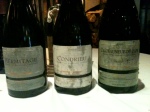 At a reception hosted by importer Wilson Daniels, the array of fine winesfrom their international portfolio was truly impressive. I felt like a kid in a candy store, as there were numerous wines that impacted me, from white Burgundy (Leflaive 2008 Pulighy-Montrachet, Laroche 2009 Reserve de l’Obedience Chablis Grand Cru and 2009 Petite Chablis) and Rhone Valley whites (Tardieu Laurent 2007 Hermitage, 2009 Condrieu and 2007 Chateauneuf-du-Pape) to Barbaresco (2005 Ceretto Bricco Asili), Tokaji Aszu (1999 Royal Tokaji 6 Puttanyos), and California Cabernet Sauvignion (2008 Lancaster Estate). Whew!
At a reception hosted by importer Wilson Daniels, the array of fine winesfrom their international portfolio was truly impressive. I felt like a kid in a candy store, as there were numerous wines that impacted me, from white Burgundy (Leflaive 2008 Pulighy-Montrachet, Laroche 2009 Reserve de l’Obedience Chablis Grand Cru and 2009 Petite Chablis) and Rhone Valley whites (Tardieu Laurent 2007 Hermitage, 2009 Condrieu and 2007 Chateauneuf-du-Pape) to Barbaresco (2005 Ceretto Bricco Asili), Tokaji Aszu (1999 Royal Tokaji 6 Puttanyos), and California Cabernet Sauvignion (2008 Lancaster Estate). Whew!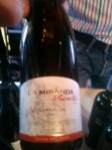 delectables with fine wines from Portuguese winery Esporao. My favorite at thistasting was the 2009 Esporao Reserva ($20), an enticing blend of indigenous and international varieties.
delectables with fine wines from Portuguese winery Esporao. My favorite at thistasting was the 2009 Esporao Reserva ($20), an enticing blend of indigenous and international varieties.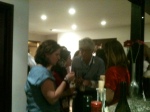

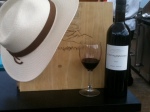 USA.This tasting featured just one wine, and an Argentinean wine at that: the 2007 Cheval des Andes ($80). This wine, a joint venture between Terrazas de Los Andes and Chateau Cheval Blanc, blends cabernet sauvignon, malbec and petite verdot into a wine that rivals the best of Bordeaux. It was so special it seemed perfectly appropriate that it was the only one at the tasting.
USA.This tasting featured just one wine, and an Argentinean wine at that: the 2007 Cheval des Andes ($80). This wine, a joint venture between Terrazas de Los Andes and Chateau Cheval Blanc, blends cabernet sauvignon, malbec and petite verdot into a wine that rivals the best of Bordeaux. It was so special it seemed perfectly appropriate that it was the only one at the tasting. Then it was to the reprise of the Kobrand happy hour. And what a treat it was to have a chance to taste many of the great Lousi Jadot Burgundies, wines even wine writers seldom get to taste. Just look at this line up! 1978 Chevalier Montrachet les Demoiselles1978 Bonnes Mares 1985 Gevrey Chambertin Clos St. Jacques 1986 Batard Montrachet 1989 Vosne Romanee Suchots 1990 Chambertin Clos de Beze 1991 Corton Charlemagne 1996 Beaune Greves 1996 Corton Pougets 1999 Meursault Genevrieres.
Then it was to the reprise of the Kobrand happy hour. And what a treat it was to have a chance to taste many of the great Lousi Jadot Burgundies, wines even wine writers seldom get to taste. Just look at this line up! 1978 Chevalier Montrachet les Demoiselles1978 Bonnes Mares 1985 Gevrey Chambertin Clos St. Jacques 1986 Batard Montrachet 1989 Vosne Romanee Suchots 1990 Chambertin Clos de Beze 1991 Corton Charlemagne 1996 Beaune Greves 1996 Corton Pougets 1999 Meursault Genevrieres.